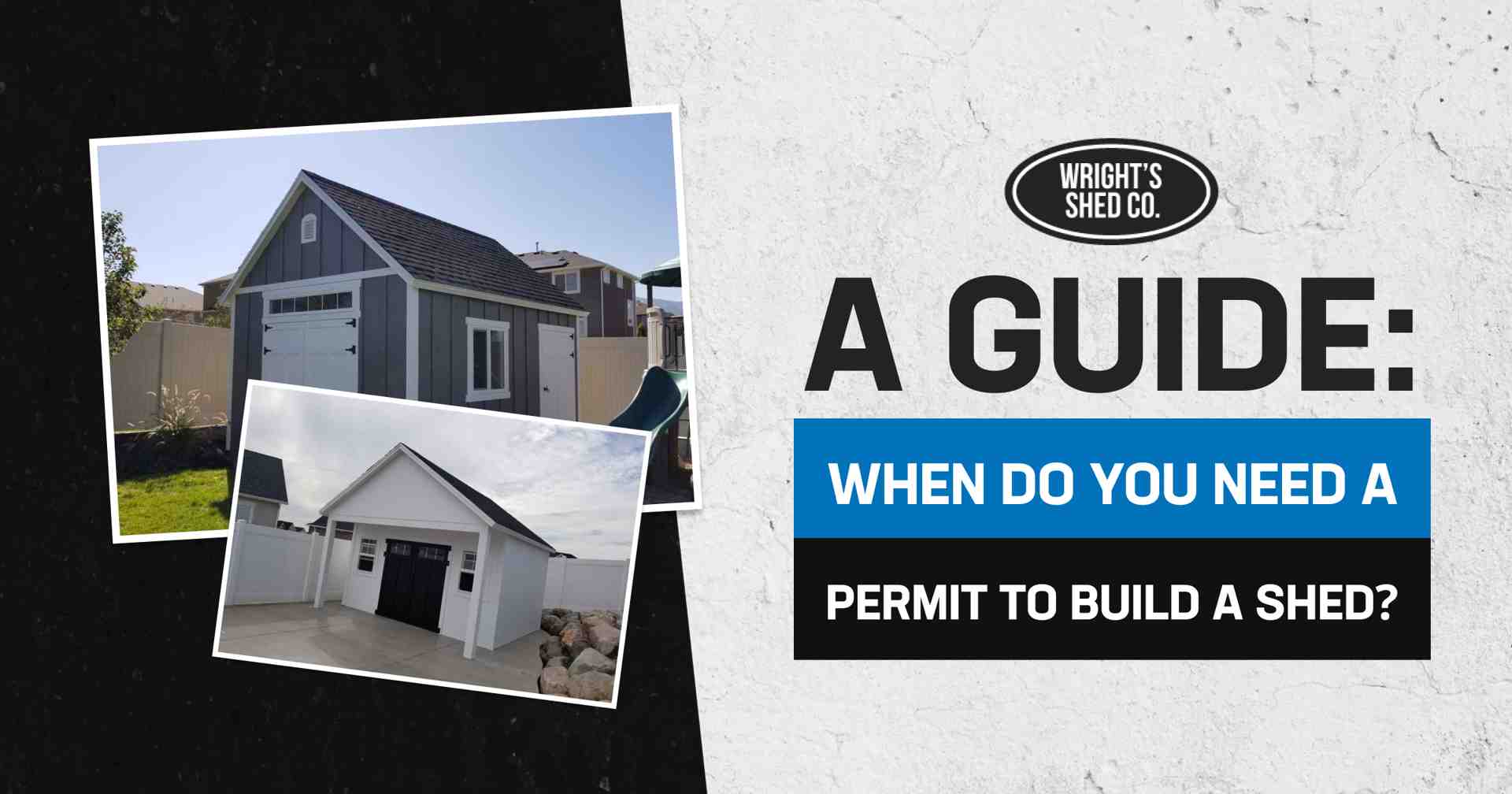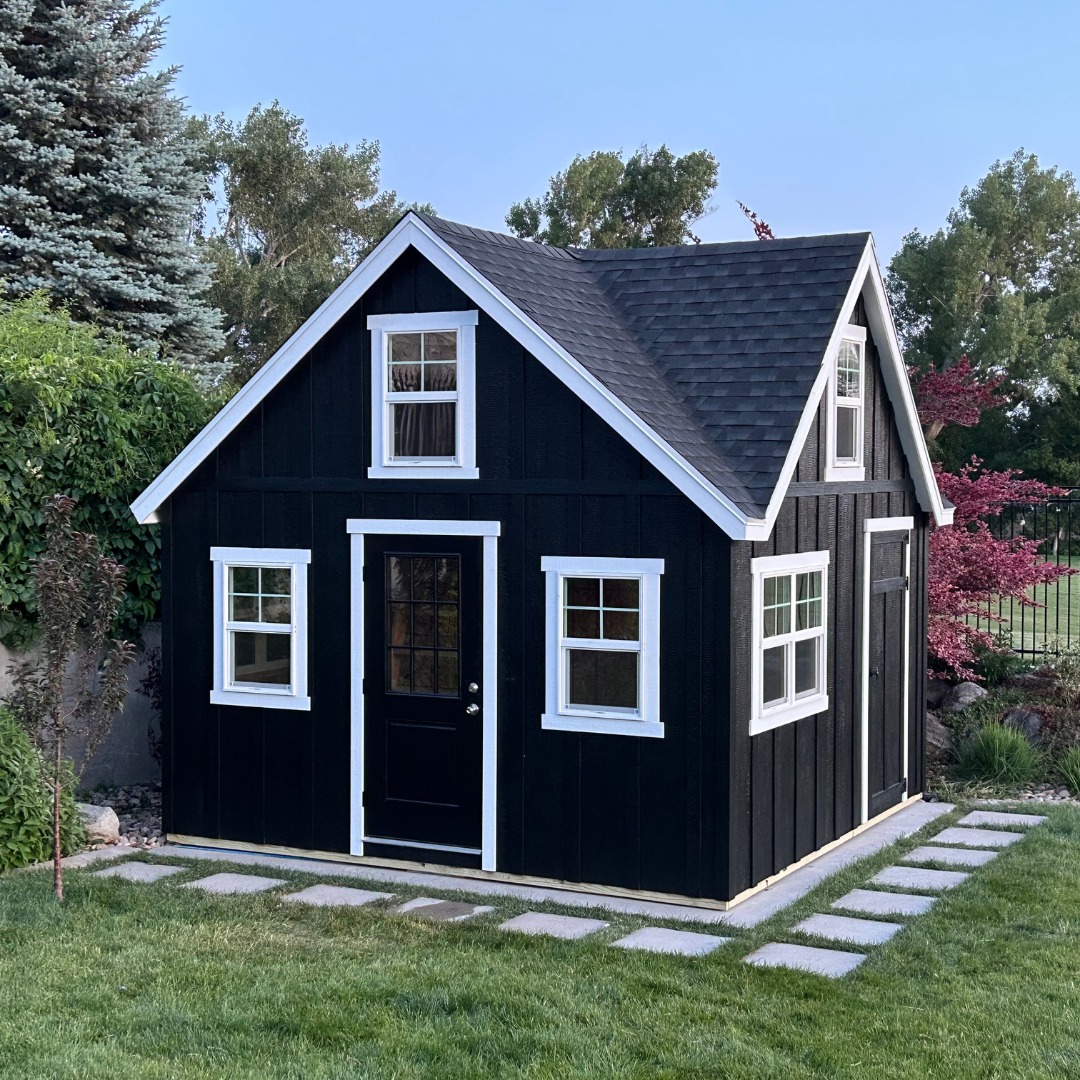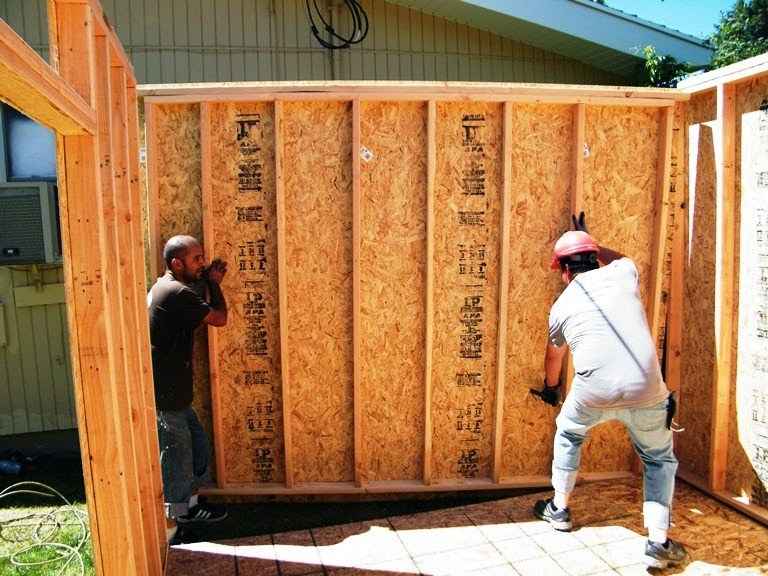Do You Need a Permit to Build a Shed? Here’s What to Know
Do you need a permit to build a shed? The answer depends on several key factors that vary by location and project specifics:
- Size: Most areas require permits for sheds over 100-200 square feet.
- Height: Single-story sheds under 12 feet are often exempt; taller structures typically need permits.
- Foundation: Permanent concrete foundations usually trigger permit requirements.
- Utilities: Adding electrical or plumbing almost always requires permits.
- Use: Storage sheds may be exempt, but workshops or living spaces need permits.
- Location: Proximity to property lines and other structures affects requirements.
The reality is that permit requirements change dramatically from one city to the next. While the Ontario Building Code requires permits for structures over 160 square feet, California sets the threshold at 120 square feet, and many Utah counties use 200 square feet as their benchmark.
Building without a required permit can lead to substantial fines, forced removal of your shed, or complications when selling your property. On the flip side, obtaining an unnecessary permit wastes time and money on a project that should be straightforward.
Getting it right from the start saves both headaches and cash.
The #1 Factor: Shed Size and Footprint
When you’re wondering “do you need a permit to build a shed?” the building department’s first question will always be about size. It’s the biggest factor in determining whether you’ll need that permit or not.
Local authorities view small sheds as minor additions, but once a shed crosses a certain size threshold, it requires official oversight for safety.
Understanding Common Size Thresholds
The magic numbers you’ll encounter most often are 120, 160, and 200 square feet. These aren’t random – they represent different approaches to balancing property owner freedom with safety oversight.
In California, many areas draw the line at 120 square feet. Cross that threshold, and you’re looking at permit paperwork. Ontario’s Building Code sets the bar at 160 square feet, while many Utah and Idaho communities are more generous, allowing storage sheds up to 200 square feet without permits.
However, rules vary dramatically even within a state, so always check locally. In Utah, for instance, there is no statewide shed code; each city sets its own rules. While many allow 200 square feet for storage, some counties have extra requirements for smaller structures.
Montreal offers another interesting example. They allow sheds up to about 161 square feet behind your home without permits, but if you want multiple outbuildings totaling more than 269 square feet, you’ll need approval. It’s these local quirks that can catch homeowners off guard.
For detailed guidance on size requirements in your area, check out our comprehensive guide on What Size Shed Needs a Permit?.
What if My Shed is Taller Than a Single Story?
Size isn’t just about footprint – height matters too. Most permit exemptions only apply to single-story structures under specific height limits, typically 10 to 12 feet.
Planning a lofted shed for extra storage? A workshop with soaring ceilings? A two-story structure? You’ll almost certainly need a permit, regardless of the footprint size.
Los Angeles County keeps it simple: one-story accessory buildings under 12 feet in height can often skip permits. Washington State takes a similar approach, requiring permits for anything taller than single-story.
These height restrictions aren’t bureaucratic nitpicking – they’re about safety and neighborhood impact. Taller structures need stronger foundations, better wind resistance, and different fire safety considerations. Plus, that two-story shed might block your neighbor’s view or cast shadows they weren’t expecting.
The roof pitch can push you over height limits too. A steep-pitched roof that looks great might add those crucial extra feet that trigger permit requirements. It’s another reason to measure carefully and check local rules before finalizing your shed design.
Beyond Size: Other Factors That Trigger a Permit
While size is a key factor, it’s not the whole story. Even a small shed can require a permit based on other considerations like safety, zoning compliance, and the impact on your property and neighbors.
Foundation and Anchoring
Your foundation choice can change permit needs, regardless of shed size. Temporary bases like skids or gravel pads rarely need permits. However, pouring a permanent concrete slab or digging frost footings almost always requires one.
Why the difference? Permanent foundations involve excavation and engineering regulated by building codes, often based on the International Residential Code. This ensures the shed won’t settle, shift, or cause drainage problems, and it signals a lasting addition to your property.
If you’re planning a permanent foundation, understanding your options is crucial. Our guides on Shed Foundation Types and How to Build a Shed Base will help you choose the right approach for both compliance and longevity.
Utilities: Electrical and Plumbing
Here’s where things get serious quickly. Even a tiny 8×10 shed that’s otherwise permit-exempt will almost certainly require permits if you’re adding electrical connections or plumbing installations. This isn’t bureaucratic overreach, it’s about keeping your family and neighbors safe.
Most areas require licensed contractors to handle any electrical work, and separate electrical permits are mandatory regardless of your shed’s size. In Manhattan, Kansas, for example, you might not need a building permit for a 150-square-foot storage shed, but you’ll definitely need an electrical permit if you’re running power to it.
The same goes for plumbing. Adding water lines or drainage transforms your simple storage shed into something that must meet much stricter safety codes. Quebec regulations specifically mention that any project requiring electrical installation or gas equipment needs professional installation, regardless of the structure’s size.
Intended Use and Occupancy
How you plan to use your shed matters enormously when determining permit requirements. A basic storage space for lawn mowers and garden tools? You’re probably fine with minimal permits. But planning a workshop with power tools, a home office for remote work, or heaven forbid, a living space? That’s a completely different conversation.
The moment your shed becomes habitable space, it must meet residential building codes covering insulation, ventilation, emergency exits, and sanitation. Duchesne County in Utah, for instance, requires permits for any shed intended for human occupancy, no matter how small.
Business use adds another layer of complexity, potentially triggering commercial zoning requirements that are far more restrictive than residential accessory structure rules.
Placement, Setbacks, and Property Lines
Where you put your shed can be just as important as what you build. Every municipality has setback requirements, which are the minimum distances your shed must maintain from property lines, your main house, and other structures. These aren’t arbitrary rules; they ensure fire separation distance for emergency access, protect utility easements, and maintain neighborhood character.
In Seattle, sheds typically need to be at least 5 feet from side and rear property lines. Many areas prohibit building directly against fences, especially those marking property boundaries. Violate these proximity rules, and you might face orders to relocate or demolish your shed, even if everything else was done correctly.
Getting the placement right from the start saves major headaches later. Our guide on how to Locate the Perfect Site for Your Shed walks you through these considerations step by step.
Homeowners Association (HOA) Rules
If you live in an HOA neighborhood, you’re dealing with an additional layer of approval that can be more restrictive than municipal requirements. Your HOA might not care whether the city requires a permit, but they’ll definitely care about your shed’s design requirements, material limitations, and compliance with neighborhood covenants and restrictions.
Many HOAs require HOA approval before you can even apply for municipal permits. They might dictate everything from roof color to window styles, and their approval process can take weeks or months. Ignoring HOA rules can result in fines, legal action, or being forced to tear down your completed shed.
The key is getting everything in writing before you start building. Municipal permits protect you from code violations, but HOA approval protects you from neighborhood disputes and potential legal troubles.
So, Do You Need a Permit to Build a Shed? The Application Process
If you’ve determined you need a permit, don’t worry. The application process is more straightforward than most people think. It’s a matter of gathering the right paperwork and submitting it to the correct office.
The whole point of the permit process is to make sure your shed gets built safely and follows your local rules. Think of it as a helpful checkpoint rather than a roadblock.
How to Confirm Your Local Requirements
Here’s where the rubber meets the road: your local building department or city planning office is the only place that can give you the final word on whether you need a permit. I can’t stress this enough: regulations change, so always verify your own requirements.
Your city’s planning or building department website should be your first stop. Most municipalities have gotten pretty good about putting their shed requirements online. In Utah, for example, many cities like those in Kane County and Washington County have online application portals that make the whole process much smoother.
If you live outside city limits, your county’s planning or building department will have jurisdiction. Sometimes county rules are more relaxed than city ordinances, but don’t assume, always check.
When in doubt, pick up the phone and call. I know it sounds old-fashioned, but a quick five-minute conversation with a building department clerk can save you weeks of confusion. Have your property address ready, along with your shed’s proposed size, what you plan to use it for, and whether you’re planning to add electricity or plumbing.
Don’t forget about your HOA if you have one. They might have their own approval process that runs parallel to the city permit.
For those of you here in Utah, we’ve put together a comprehensive guide on Utah Building Code for Sheds that covers the specific quirks of our state’s regulations.
What documents are generally required when applying for a shed permit?
The paperwork may seem overwhelming at first, but most shed permits require a similar set of documents to explain your project clearly. Here’s what you’ll typically need:
- Site Plan
A top-down drawing of your property showing:- Your house, property lines, and the shed’s exact location.
- Distances from property lines and other structures.
- A hand-drawn sketch with accurate measurements is usually acceptable.
- Construction Drawings or Plans
- Show how the shed will be built.
- Prefab sheds can often use manufacturer specs.
- Custom builds require more detailed plans (dimensions, materials, foundation type).
- Wright’s Shed Co. provides all required drawings for our clients’ permit applications.
- Certificate of Location
- Confirms your property boundaries and existing structures.
- Provided by a local surveyor.
- In some cases, a recent property survey may be accepted instead.
- Cost Estimate
- Used to calculate permit fees (usually based on project value).
- Be accurate and honest, low estimates can lead to issues later.
- Proof of Ownership & HOA Approval
- A deed or title to confirm property ownership.
- Written HOA approval, if required in your neighborhood.
Getting all this together before you apply will speed things up considerably. For more details on the entire process from planning to completion, check out our guide on The Shed Building Process Step by Step.
Typical Permit Costs and Timelines
Let’s talk money and time, the two things everyone wants to know about permits. Shed permit costs typically range from about $50 to $145, though this varies quite a bit depending on where you live and how much your project costs.
Many cities calculate fees as a percentage of your project’s estimated value, usually with a minimum fee. In Boise, Idaho, for example, they charge $70.76 for the first $2,000 in project value, then $12.71 for each additional $1,000 up to $25,000. Montana typically charges 1% to 2% of the project value with a minimum fee around $23.50.
Watch out for additional fees that might pop up. Things like being too close to a septic system or needing special inspections can add hundreds to your permit cost.
Processing time is usually somewhere between a few days and several weeks. Here in Utah, most departments respond within 14 working days, which is pretty reasonable. However, if you’re applying during busy spring building season or if your project is complex, it could take longer.
Once you get your permit, don’t let it expire! Most permits are good for 6 months to a year, and if you don’t start construction within that timeframe, you might have to pay a reopening fee or even reapply entirely.
The key is planning ahead. Apply for your permit well before you want to start building, especially if you’re hoping to get your shed up before winter or a specific deadline.
The Risks of Building Without a Permit
What happens if you decide to skip the permit process and build anyway? While tempting, building without a required permit is a major risk to your wallet and your peace of mind.
The consequences aren’t just theoretical. Over my 27 years in the business, I’ve seen homeowners face some pretty tough situations when they thought they could fly under the radar.
What are the consequences of building a shed without a required permit?
Building without a permit isn’t a criminal offense, but the consequences are serious and can cost you thousands.
Fines and penalties are usually the first consequence you’ll face. Most municipalities don’t just slap you with the original permit fee. They often double it as punishment for doing the work without permission. What could have been a $75 permit suddenly becomes a $150 fine, plus you still need to get the actual permit.
But it gets worse. Authorities can issue a stop-work order, which means your project comes to a screeching halt until you sort everything out.
In extreme cases, if your shed violates setback rules or other codes and can’t be brought into compliance, you might face forced removal. Imagine having to tear down a shed you just spent weeks building, and paying for the demolition yourself.
Insurance complications are another headache most people don’t think about. Many homeowner’s insurance policies won’t cover damages involving unpermitted structures. If a storm damages your unpermitted shed and it causes damage to your neighbor’s property, you could be on the hook for everything.
Perhaps the biggest long-term risk is what happens when you try to sell your home. Unpermitted structures show up during inspections and can derail a sale faster than you can say “closing costs.” Buyers get nervous about potential legal issues, and you might end up having to remove the shed or obtain retroactive permits just to complete the sale.
HOA penalties add another layer of complexity if you live in a neighborhood with an association. They can impose their own fines and demand removal, completely separate from any municipal action.
The bottom line? That small upfront savings from skipping the permit process rarely outweighs the potential costs and stress down the road. Getting it right the first time isn’t just about following rules , it’s about protecting your investment and your sanity.
Frequently Asked Questions about Do You Need a Permit to Build a Shed
After helping thousands of customers steer shed permits across Utah, Idaho, Iowa, and Nebraska, we’ve heard just about every question you can imagine about do you need a permit to build a shed. Here are the most common ones that come up, along with the straight answers you need.
How do I find out the specific setback requirements for my property?
Your local zoning or planning department is the definitive source for setback rules. These distances determine how far your shed must be from property lines, your house, and other structures. Most cities and counties now put this information on their websites. Your property’s plat map is another goldmine of information that shows these boundaries clearly.
When in doubt, a quick phone call to the zoning office usually gets you the answer in minutes. Here’s a pro tip: always ask for the specific ordinance number when they give you information over the phone. This way, you can look it up yourself and have the exact regulation in writing. Trust me, it’s better to have it documented than to rely on memory when you’re measuring out your shed placement.
Does attaching a shed to my house change the permit requirements?
Yes, attaching a shed to your house almost always changes the permit requirements. It’s no longer considered an accessory building but a home addition, which brings stricter rules.
This classification shift brings a whole different set of rules. Attached structures typically need to meet the same standards as your main house, including foundation requirements, structural codes, insulation standards, and fire safety regulations. Even a tiny attached shed that would normally be permit-exempt as a standalone structure will almost certainly require a building permit once it’s connected to your home.
The electrical and plumbing considerations get more complex too, since any utilities would tie directly into your home’s existing systems. It’s a much higher bar to clear than a simple detached storage shed, regardless of the size.
Can I get a permit after I’ve already built the shed?
Yes, but getting a retroactive permit is complicated and more expensive. It comes with some serious downsides.
First, expect to pay penalty fees that can double the original permit cost. Then comes the inspection process, which is much more intensive than a standard permit inspection. Inspectors might require you to tear open walls, expose the foundation, or remove siding to prove that your shed meets current building codes.
Here’s where it gets really tricky: if your shed has major violations, maybe it’s too close to a property line, built on an inadequate foundation, or constructed with materials that don’t meet code, you might face an order to tear it down entirely.
The bottom line? Getting the permit before you build saves you money, stress, and potential heartbreak down the road. It’s one of those situations where doing it right the first time is definitely the easier path.
Do You Need a Permit to Build a Shed? Here’s the Bottom Line
Now that you understand shed permit requirements, you can move forward with confidence. While the answer isn’t always a simple yes or no, having the right information helps you make the best decision for your project.
The most important thing to remember is that every location is different. What’s true for your neighbor in the next county over might not apply to your property. That’s why we always tell our customers to start with their local building department. A quick phone call or website visit can save you from costly mistakes down the road.
Planning ahead makes everything smoother. Factor in time for permit research and applications when you’re mapping out your project timeline. Trust me, it’s much easier to get approval upfront than to deal with stop-work orders or retroactive permits later. I’ve seen too many excited homeowners hit roadblocks because they rushed into construction without doing their homework first.
Permits aren’t just red tape; they exist to protect you, your family, and your neighbors. Safety and compliance should always be the priority. A properly permitted shed provides peace of mind that your investment is sound and won’t cause issues when you sell your home.
At Wright’s Shed Co., we’ve been helping customers steer these waters since 1997. Over nearly three decades of building custom storage sheds, garages, and chicken coops across Utah, Idaho, Iowa, and Nebraska, we’ve learned that understanding local regulations is just as important as quality construction. Our team knows the building landscape in our service areas, and we’re always happy to share that knowledge with our customers.
Whether you’re planning a simple storage shed for garden tools or a more complex workshop with electrical connections, getting the permit question answered early sets you up for success. If you’re still wondering about size requirements specifically, our guide on What Size Shed Needs a Permit? dives deeper into those details.
The bottom line? A little research upfront can save you a lot of headaches later. Your future self will thank you for taking the time to do things right from the start.





